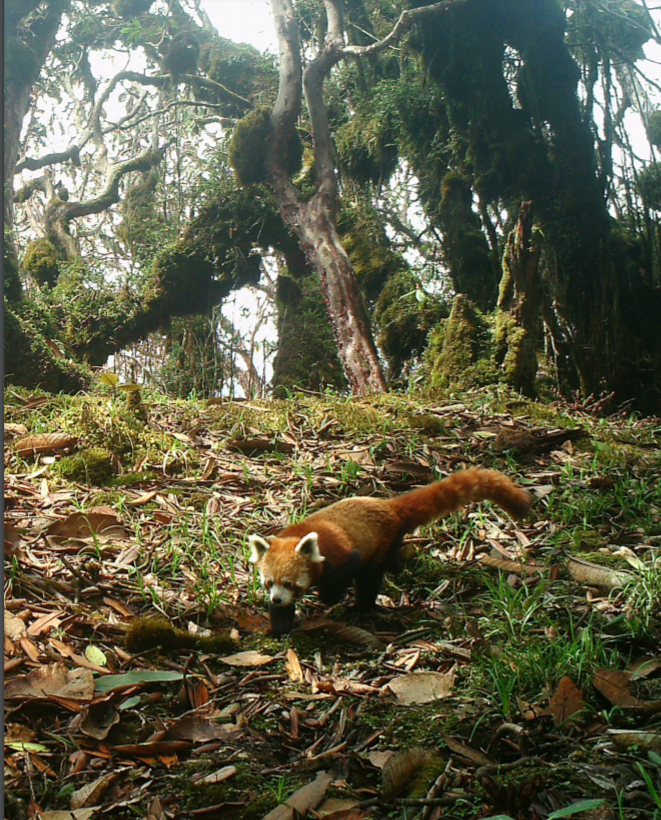
First in Nepal, and most recently Bhutan, governments are committing to red panda conservation in range countries.
On July 31, 2019, people and charities all over the world celebrated World Ranger Day. This day honors the critical work of rangers to protect our planet’s wildlife and natural resources. For many endangered species—including the red panda—the enforcement of national laws by local authorities is critical for survival. It’s no coincidence that July 31st was the same day Bhutan launched a five-year action plan to conserve red pandas.
Red Pandas are endangered. While their numbers seem to be improving in Red Panda Network’s (RPN) project areas in Eastern Nepal, the species continues to face imminent threats to their survival in red panda range countries. The primary threats are habitat loss and fragmentation, which are being driven by poverty, growing human population and a paucity of adequate conservation programs.
 Red panda conservation workshop. Photo from Bhutan's action plan.
Red panda conservation workshop. Photo from Bhutan's action plan.
Fortunately, governments in range countries are beginning to recognize the need for national red panda conservation strategies. This change has been gradual, but a movement is growing.
The commitment to protect red pandas originated in Nepal: In September of 2018, Nepal launched a five-year red panda conservation action (2019-2023). This was the first of such guidelines that provide a thorough framework for engaging local communities and strengthening coordination among conservation actors at national and international levels.
“This is an exciting achievement,” says RPN’s Country Director, Ang Phuri Sherpa. “To have clear objectives and methodologies at a country-level—that can be replicated by other range countries—is a big step towards preserving pandas for future generations.”
RPN played a key role in advocating for and developing the plan. We are also helping to ensure its effective implementation under the leadership of the Department of National Parks and Wildlife Conservation and Department of Forest and Soil Conservation of the government of Nepal.
 Cover of Nepal's red panda conservation action plan.
Cover of Nepal's red panda conservation action plan.
 Cover of Bhutan's red panda conservation action plan.
Cover of Bhutan's red panda conservation action plan.
In Bhutan, the presence of red panda has been confirmed in seventeen districts; including seven of the ten protected areas, and eight of the nine biological corridors (within the altitudinal range of 2000 meters to 4300 meters above sea level). However, population status and density are unknown. The action plan aims to conduct extensive research to understand red panda population dynamics, ecological roles, socio-cultural significance, breeding behaviors, and movement ecology.
“I am confident that this action plan will be a guiding document to all concerned stakeholders of red panda conservation,” says Rinzin Dorji, secretary, Ministry of Agriculture and Forests, Bhutan.
The action plan emphasizes habitat management and protection, conservation education, strengthening local red panda stewardship, rural livelihood enhancement, and improved coordination among stakeholders. The plan also identifies increased developmental activities, unsustainable livestock grazing and harvest of non-timber forest products, and subsistence agriculture as the drivers of threats to red panda.

Wild red panda in Bhutan. Photo from conservation action plan.
“It is encouraging to see range countries come together to conserve red panda,” says Sherpa of RPN.
One of the key objectives highlighted in both Nepal and Bhutan’s action plans are strengthening trans-boundary collaboration to conserve red panda. Red panda habitat often expands multiple countries and their survival is threatened by illegal wildlife trade through routes that are transboundary and interconnected. For instance, red panda habitat in Nepal extends into China in the north and India in the south, and this connectivity facilitates the trafficking of wildlife, including red pandas. Poaching of red panda is not yet reported in Bhutan, however, accidental killing by poachers while hunting highly prized musk deer and predation from free-roaming dogs are reported from the field.
“The plan aims to identify transboundary red panda habitat corridors and carry out threat analysis for initiating regional landscape-level conservation programs,” says Dr. Joanna Miller who provided inputs during the development of Bhutan’s red panda conservation action plan. Miller is a senior research fellow, Environment and Livelihoods at Charles Sturt University, Australia.
